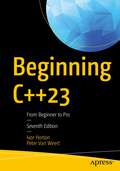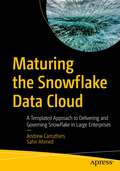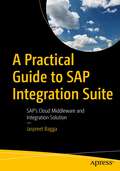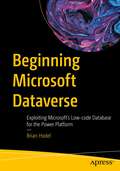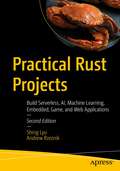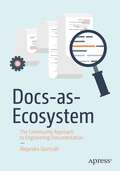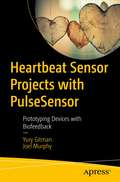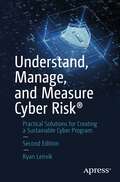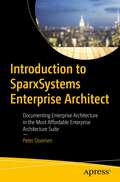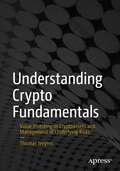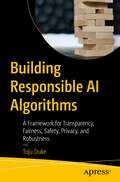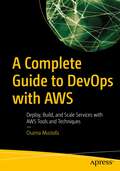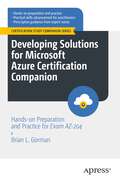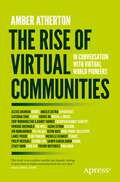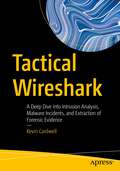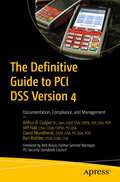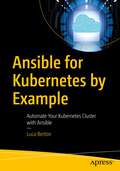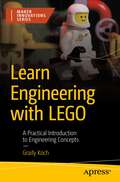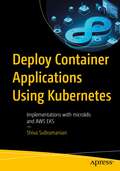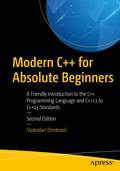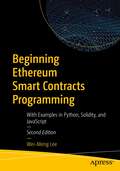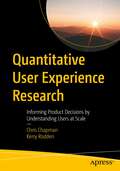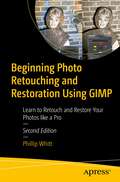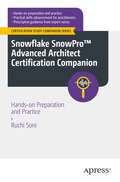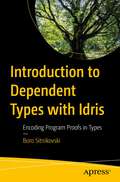- Table View
- List View
Beginning C++23: From Beginner to Pro
by Ivor Horton Peter Van WeertBegin your programming journey with C++ , starting with the basics and progressing through step-by-step examples that will help you become a proficient C++ programmer. This book includes new features from the C++23 standard. All you need are Beginning C++23 and any recent C++ compiler and you'll soon be writing real C++ programs. There is no assumption of prior programming knowledge. All language concepts that are explained in the book are illustrated with working program examples, and all chapters include exercises for you to test and practice your knowledge. Free source code downloads are provided for all examples from the text and solutions to the exercises. This latest edition has been fully updated to the latest version of the language, C++23, and to all conventions and best practices of modern C++. This book also introduces elements of the C++ Standard Library that provide essential support for C++23. After completing this book, you will have the knowledge and skills needed to build your first C++ applications. What You Will LearnBegin programming with the C++23 standardCarry out modular programming in C++Work with arrays and loops, pointers and references, strings, and moreWrite your own functions, types, and operatorsDiscover the essentials of object-oriented programmingUse overloading, inheritance, virtual functions, and polymorphismWrite generic function and class templates, and make them safer using concepts Learn the ins and outs of containers, algorithms, and rangesUse auto type declarations, exceptions, move semantics, lambda expressions, and much moreWho This Book Is ForProgrammers new to C++ and those who may be looking for a refresh primer on C++ in general.
Maturing the Snowflake Data Cloud: A Templated Approach to Delivering and Governing Snowflake in Large Enterprises
by Andrew Carruthers Sahir AhmedThis project-oriented book gives you a hands-on approach to designing, developing, and templating your Snowflake platform delivery. Written by seasoned Snowflake practitioners, the book is full of practical guidance and advice to accelerate and mature your Snowflake journey. Working through the examples helps you develop the skill, knowledge, and expertise to expand your organization’s core Snowflake capability and prepare for later incorporation of additional Snowflake features as they become available. Your Snowflake platform will be resilient, fit for purpose, extensible, and guarantee rapid, consistent, and repeatable, pattern-based deployments ready for application delivery.When a Snowflake account is delivered there are no controls, guard rails, external monitoring, nor governance mechanisms baked in. From a large organization perspective, this book explains how to deliver your core Snowflake platform in the form of a Landing Zone, a consistent, templated approach that assumes familiarity with Snowflake core concepts and principles. The book also covers Snowflake from a governance perspective and addresses the “who can see what?” question, satisfying requirements to know for certain that your Snowflake accounts properly adhere to your organization’s data usage policies.The book provides a proven pathway to success by equipping you with skill, knowledge, and expertise to accelerate Snowflake adoption within your organization. The patterns delivered within this book are used for production deployment, and are proven in real-world use. Examples in the book help you succeed in an environment in which governance policies, processes, and procedures oversee and control every aspect of your Snowflake platform development and delivery life cycle. Your environment may not be so exacting, but you’ll still benefit from the rigorous and demanding perspective this book’s authors bring to the table. The book shows you how to leverage what you already know and adds what you don’t know, all applied to deliver your Snowflake accounts. You will know how to position your organization to deliver consistent Snowflake accounts that are prepared and ready for immediate application development.What You Will LearnCreate a common, consistent deployment framework for Snowflake in your organizationEnable rapid up-skill and adoption of Snowflake, leveraging the benefits of cloud platformsDevelop a deep understanding of Snowflake administration and configurationImplement consistent, approved design patterns that reduce account provisioning timesManage data consumption by monitoring and controlling access to datasetsWho This Book Is ForSystems administrators charged with delivering a common implementation pattern for all Snowflake accounts within an organization; senior managers looking to simplify the delivery of complex technology into their existing infrastructure; developers seeking to understand guard rails, monitoring, and controls to ensure that Snowflake meets their organization's requirements; sales executives needing to understand how their data usage can be monitored and gain insights into how their data is being consumed; governance colleagues wanting to know who can see each data set, and wanting to identify toxic role combinations, and have confidence that their Snowflake accounts are properly provisioned
A Practical Guide to SAP Integration Suite: SAP’s Cloud Middleware and Integration Solution
by Jaspreet BaggaThis book covers the basics of SAP’s Integration Suite, including a broad overview of its capabilities, installation, and real-life examples to illustrate how it can be used to integrate, develop, administer, and monitor applications in the cloud.As you progress through the book, you will see how SAP Integration Suite works as an open, enterprise-grade platform that is a fully vendor-managed, multi-cloud offering that will help you expedite your SAP and third-party integration scenarios. The entire value chain is explored in detail, including usage of APIs and runtime control.Author Jaspreet Bagga demonstrates how SAP’s prebuilt integration packages facilitate quicker, more comprehensive integrations, and how they support a variety of integration patterns. You’ll learn how to leverage the platform to enable seamless cloud and on-premises applications connectivity, develop custom scenarios, mix master data, blend business-to-business (B2B) and electronic data interchange (EDI) processes, including trading partner management. Also covered are business-to-government (B2G) scenarios, orchestrating data and pipelines, and mixing event-driven integration. Upon completing this book, you will have a thorough understanding of why SAP Integration Suite is the middleware of SAP’s integration strategy, and be able to effectively use it in your own integration scenarios.What You Will LearnUnderstand SAP Integration Suite and its core capabilitiesKnow how integration technologies, such as architecture and supplementary intelligent technologies, work within the SAP Integration SuiteDiscover services for pre-packaged accelerators: SAP API Management, the Integration Advisor, and the SAP API Business HubUtilize integration features to link your on-premises or cloud-based systemsUnderstand the capabilities of the newly released Migration AssessmentWho This Book Is forWeb developers and application leads who want to learn SAP Integration Suite.
Beginning Microsoft Dataverse: Exploiting Microsoft’s Low-code Database for the Power Platform
by Brian HodelUnderstand the role that Dataverse plays in the low-code revolution that helps businesses gain advantage from being more agile with technology. This book shows you how to use Dataverse to solve business problems by describing the layers of a solution in the Power Platform and the options that exist at each layer so you can make informed decisions as you develop your solutions. The book shows how Dataverse is a central piece of the Microsoft Power Platform and helps tech-savvy professionals move nimbly and seize the day when opportunities present themselves. The book starts out by covering the platform in terms of its layers so you can orient yourself with the features that exist at each level and what that means to you as a developer. You will learn how to work inside the data layer to design tables to store data and relationships and manage how it all works together. You will learn how to apply business logic and validation in the business layer to ensure data integrity and enforce process compliance. You will learn how to design interfaces in the presentation layer to allow users to interact with your data and processes in user-friendly applications. And you will learn how to utilize third-party integration tools to create seamless connections between your solution and legacy systems so you can develop enterprise-grade tools in record time. What You Will LearnUnderstand the layers of Dataverse and the features at each layerCreate tables and relationships to store data and manage interactionsBuild applications to allow users to interact with your data using logical interfacesDesign business logic and workflows to ensure data integrity and automationConfigure security to control access to data and prevent unauthorized accessExplore the options for integration with third-party systems Who This Book Is ForMicrosoft Power Platform users who want to learn how to access the power of the Power Platform and leverage Dataverse to build powerful, robust, and resilient tools; power users and citizen developers who are looking for tools to quickly build scalable business solutions that don’t require a strong developer background; pro developers who want to learn how to utilize use the Power Platform to speed up the development cycle and deliver value to customers faster than ever before
Practical Rust Projects: Build Serverless, AI, Machine Learning, Embedded, Game, and Web Applications
by Shing Lyu Andrew RzeznikGo beyond the basics and build complete applications using the Rust programming language, updated for Rust 2021 edition. The applications you'll build over the course of this book include a high-performance web client, an embedded computer (for a robot, for example), a game, a serverless web app, and an application that incorporates AI and machine learning. Each chapter is organized in the following format: what the kind of should application look like; requirements and user stories of our example program; an introduction to the Rust libraries used; the actual implementation of the example program, including common pitfalls and their solutions; and a brief comparison of libraries for building each application, if there is no clear preference. Practical Rust Projects, Second Edition will open your eyes to how Rust can be put to practical, real-world use. After reading this book, you will be able to use Rust to build a variety of your own projects. What You Will Learn Explore practical Rust programming language-based projects, examples and case studiesCreate a GUIBuild a high performance web Front-end using WebAssemblyDevelop REST APIs using RustGo serverless to develop a cloud application using the Amazon AWS Rust SDKCreate a game using Rust, along with AI and machine learning apps Who This Book Is For Those with basic Rust knowledge who want to learn more about how to apply Rust in real-world scenarios.
Docs-as-Ecosystem: The Community Approach to Engineering Documentation
by Alejandra QuetzalliInvesting in engineering documentation (Docs) means investing in community user experience. This book teaches readers how mastering the docs-as-code ecosystem empowers communities to understand better their favorite products and Open-Source (OSS) technologies better. Author Alejandra Quetzalli believes that “docs-as-ecosystem” represents a more comprehensive and collaborative approach to documentation development than “docsas- code” because it recognizes that documentation is more than just code. Docs involve technical writing, design, community feedback, community management, accessibility, SEO, UX, and today… even Artificial Intelligence tools! The word ecosystem promotes a paradigm where we treat documentation as a complex and dynamic system that must be managed and nurtured. In this book, you’ll acquire practical skills such as creating public style guides, incorporating responsive and accessible design, designing user flows and information architecture, retrieving user feedback, and setting up Docs analytics. You’ll learn to identify the difference in work processes between maintaining Docs for a product versus an OSS technology. You’ll discover the secrets to managing technical writers and OSS contributions, all while building a thriving Docs community. To end on a futuristic note, you’ll discover why technical writers who harness Artificial Intelligence (AI) tools (i.e., ChatGPT) need not fear a robot uprising anytime soon. What You'll LearnExamine accessibility and the user experienceUnderstand Information architecture Review docs-as-ecosystem processes Manage technical writersOversee OSS Docs contributions Retrieve and integrate user feedback Build Docs and Education communities Who This Book is ForDevelopers of all levels, VPs of Product/Engineering, Product Managers, and Designers,
Heartbeat Sensor Projects with PulseSensor: Prototyping Devices with Biofeedback
by Yury Gitman Joel MurphyBring live heartbeats and heart rate data into your electronics projects as an impressive feature that builds user engagement. If you’re a Maker, developer, or artist, you’ve probably run into common, frustrating stumbling blocks for incorporating bio-sensors. Get the upper hand on smoothly integrating heartbeats into your projects on any platform with PulseSensor. First, you'll explore working with PulseSensor with a simple battery, LED, and speaker. Then deepen your knowledge by going through achievable projects using Arduino, nRF52, mico:bit, and other prototyping platforms. This book will guide you through hooking up the PulseSensor to circuits with motors, a GUI, and even the cloud. You’ll get practical tips and tricks that work in the lab, field, and even at public events, and look at the advantages of using PulseSensor on one electronics platform vs. another. You'll also look at the best ways to get a reliable heartbeat and BPM readings from different users in different applications. Finally, this book will show you the easiest path to put heartbeats into your prototypes, whether creating a new generation of hardware or making a memorable cosplay costume. What You'll LearnWork with PulseSensor directly on a breadboard with AA batteries and LEDs Get up and running with PulseSensor on Arduino, micro:bit, and nRF52 Anticipate and address common bio-sensing issues that slow down prototyping Explore future applications like BPM tracking on the Arduino IoT CloudWho This Book Is ForMakers from hobbyists to engineers to students who would like to incorporate cardiac biofeedback into their projects.
Understand, Manage, and Measure Cyber Risk: Practical Solutions for Creating a Sustainable Cyber Program
by Ryan LeirvikWhen it comes to managing cybersecurity in an organization, most organizations tussle with basic foundational components. This practitioner’s guide lays down those foundational components, with real client examples and pitfalls to avoid. A plethora of cybersecurity management resources are available—many with sound advice, management approaches, and technical solutions—but few with one common theme that pulls together management and technology, with a focus on executive oversight. Author Ryan Leirvik helps solve these common problems by providing a clear, easy-to-understand, and easy-to-deploy "playbook" for a cyber risk management approach applicable to your entire organization.This second edition provides tools and methods in a straight-forward, practical manner to guide the management of a cybersecurity program. Expanded sections include the critical integration of cyber risk management into enterprise risk management, the important connection between a Software Bill of Materials and Third-party Risk Programs, and additional "how to" tools and material for mapping frameworks to controls.Praise for Understand, Manage, and Measure Cyber RiskWhat lies ahead of you in the pages of this book? Clean practicality, not something that just looks good on paper—brittle and impractical when exposed to the real world. I prize flexibility and simplicity instead of attempting to have answers for everything and the rigidity that results. This simplicity is what I find valuable within Ryan's book. Tim Collyer, Motorola SolutionsIt seems that I have found a kindred spirit—a builder who has worked with a wide variety of client CISOs on their programs, gaining a deep understanding of how a successful and sustainable program should be constructed. Ryan's cyber work in the US Department of Defense, his McKinsey & Company consulting, and his advisory and survey work with IANS give him a unique global view of our shared passion. Nicholas J. Mankovich, PhD, MS, CISPPWho This Book Is For CISOs, CROs, CIOs, directors of risk management, and anyone struggling to pull together frameworks or basic metrics to quantify uncertainty and address risk
Introduction to SparxSystems Enterprise Architect: Documenting Enterprise Architecture in the Most Affordable Enterprise Architecture Suite
by Peter DoomenSparxSystems Enterprise Architect (EA) is a logical choice for many companies and organizations: it combines a broad feature set with an affordable price. However, the robust range of features makes starting to use this fantastic tool a bit intimidating. Enter Michael, a fictional consultant and experienced enterprise architect featured throughout the book to show you how to populate a model with elements and connectors, and how to create diagrams that speak to the audience: management, project managers, internal audit, business stakeholders and IT representatives. As the book progresses Michael's duties continue with more advanced topics including the use of workflow tools such as Kanban boards. You'll even see how to present directly from Enterprise Architect so that latest information can be shown straight from the source! The last days of Michael’s mission are devoted to fine-tuning the enterprise architecture model with the help of tagged values. And to leave the model in the hands of the customer by creating a custom toolbox. What You'll Learn Setup EA and populate a model with elements, connectors and diagramsReview the Big Five of enterprise architect: Model, Packages, Diagrams, Elements, ConnectorsImplement evidence-based best practice strategies aligned with overall goalsWho This Book Is ForNon-technical users who use EA mainly to document entire landscapes.
Understanding Crypto Fundamentals: Value Investing in Cryptoassets and Management of Underlying Risks
by Thomas JeegersSaying that many investors were not convinced by cryptocurrencies in their first decade of existence would be an understatement. Originally, author Thomas Jeegers was one of them. He looked into this new virtual money more than once and, each time, decided not to invest. Like many long-term investors, he was looking for fundamentals. Crypto had none — or so he thought. This book details why his perspective on cryptoassets has shifted – and why yours should, too. Recent developments in this field have turned crypto from a speculative financial innovation to a new asset class, one with a new kind of fundamentals that offer real economic value. One that will change finance and investments. One that may be a trigger defining the fourth industrial revolution, the same way steam, electricity, and the Internet were triggers for the first, second, and third industrial revolutions, respectively. Despite what advocates of the traditional financial establishment like to claim, cryptoassets were by far the best financial investment of the last decade, even risk-adjusted, and could still be so for the coming one. They should not be overlooked, regardless of one’s opinion of them. This book answers the main questions any potential long-term investor in cryptoassets should ask: What are cryptoassets and blockchain technology?Why consider cryptoasset investments?When is a good time to invest?Where should one invest? How should one invest? Which valuation methods are appropriate? Understanding Crypto Fundamentals includes a deep dive into the management of risks specific to cryptoassets, both financial and non-financial, and provides the tools needed for investment success in this new asset class. Upon completing the book, you will have a new perspective on cryptoassets and how you can benefit from them as an investor.Thomas Jeegers is a CFA Charterholder and Financial Risk Manager (FRM), and has earned an MBA from INSEAD as well as multiple blockchain certifications from institutions including INSEAD and Oxford University. He has worked in finance for 10 years and is a frequent speaker at events on blockchain and cryptoassets.
Building Responsible AI Algorithms: A Framework for Transparency, Fairness, Safety, Privacy, and Robustness
by Toju DukeThis book introduces a Responsible AI framework and guides you through processes to apply at each stage of the machine learning (ML) life cycle, from problem definition to deployment, to reduce and mitigate the risks and harms found in artificial intelligence (AI) technologies. AI offers the ability to solve many problems today if implemented correctly and responsibly. This book helps you avoid negative impacts – that in some cases have caused loss of life – and develop models that are fair, transparent, safe, secure, and robust.The approach in this book raises your awareness of the missteps that can lead to negative outcomes in AI technologies and provides a Responsible AI framework to deliver responsible and ethical results in ML. It begins with an examination of the foundational elements of responsibility, principles, and data. Next comes guidance on implementation addressing issues such as fairness, transparency, safety, privacy, and robustness. The book helps you think responsibly while building AI and ML models and guides you through practical steps aimed at delivering responsible ML models, datasets, and products for your end users and customers. What You Will LearnBuild AI/ML models using Responsible AI frameworks and processesDocument information on your datasets and improve data qualityMeasure fairness metrics in ML modelsIdentify harms and risks per task and run safety evaluations on ML modelsCreate transparent AI/ML modelsDevelop Responsible AI principles and organizational guidelinesWho This Book Is ForAI and ML practitioners looking for guidance on building models that are fair, transparent, and ethical; those seeking awareness of the missteps that can lead to unintentional bias and harm from their AI algorithms; policy makers planning to craft laws, policies, and regulations that promote fairness and equity in automated algorithms
A Complete Guide to DevOps with AWS: Deploy, Build, and Scale Services with AWS Tools and Techniques
by Osama MustafaGain a thorough understanding of DevOps concepts and learn to deploy AWS DevOps services in an organization. This book covers AWS DevOps deployment and building applications and services for enhanced performance. A Complete Guide to DevOps with AWS will show you how to use AWS DevOps to launch and scale services using AWS tools. It demonstrates how to handle infrastructure as code such as AWS CodeCommit, AWS CodeBuild, and AWS CodeArtifact, and how to adapt your software with familiar tools such as terraform and cloud formation. This practice also helps in the continuous integration and deployment of pipelines such as AWS CodeDeploy and AWS CodePipeline with different deployment strategies. You will also learn how to find bugs quicker, enhance software quality, reduce your time to market, and how to build, test, and prepare for a release with frequent code changes. You will also see how to scale your applications to provide maximum performance for users with high traffic. The book also covers monitoring and logging applications, giving an overall picture of the ecosystem of product development. It also explains Kubernetes in depth with AWS EKS. It concludes by walking you through how to build projects with AWS DevOps tools and technologies. After completing this book, you will have gained a solid understanding of the concepts of AWS DevOps through examples, including building projects with integration of software tools. What You Will Learn Automate processes with AWS toolsUnderstand AWS Services for Continuous deployment, and how to use themUse infrastructure as code with AWS in different formatsIntegrate AWS security into DevOps Who This Book Is For DevOps professionals and cloud engineers.
Developing Solutions for Microsoft Azure Certification Companion: Hands-on Preparation and Practice for Exam AZ-204 (Certification Study Companion Series)
by Brian L. GormanImprove your odds of passing one of the most highly sought-after exams for developers working with Microsoft’s cloud platform: Exam AZ-204: Developing Solutions for Microsoft Azure. This book guides you through practical examples of each of the technologies covered by the exam while exposing you to the settings and interactions between platform solutions that you will need to be in command of to prepare for the exam and to use on your job in Azure development.Chapters in this book correspond directly to the exam skills outline and are delivered in a “from-the-ground-up” approach, allowing you to build your knowledge as you go. This approach serves to help even novice developers get up to speed quickly, while allowing more experienced developers to find the exact topics and scenarios they need to hone their skill sets as they both prepare for the exam and reference information for real-world solutions.As you work through each chapter, you will get an introduction to the topic of the chapter followed by a comprehensive discovery of the key elements of the Azure service(s) being covered. You’ll be guided through solutions by studying typical, real-world scenarios. Each chapter concludes with review questions to solidify your learning and includes links to the corresponding Microsoft Learn modules that are relevant to the concepts in the chapter and associated with each section of the AZ-204 exam.What You Will LearnKnow the essential platform services of AzureDevelop and deploy secure and robust web solutionsArchitect and create serverless solutionsManage containers in the Azure Containers ecosystemChoose the correct messaging and event-handling tools for your applicationsMaster real-world examples and challenges that help prepare you for the AZ-204 examWho This Book Is ForDevelopers planning to take the AZ-204 exam, and developers who want to learn more about development on the most common Azure platform services
The Rise of Virtual Communities: In Conversation with Virtual World Pioneers
by Amber AthertonUncover the fascinating history of virtual communities and how we connect to each other online. The Rise of Virtual Communities, explores the earliest online community platforms, mapping the technological evolutions, and the individuals, that have shaped the culture of the internet.Read in-depth interviews with the visionary founders of iconic online platforms, and uncover the history of virtual communities and how the industry has developed over time. Featuring never-before told stories, this exploration introduces new ideas and predictions for the future, explaining how we got here and challenging what we think we may know about building online communities.Readers will: Learn what a virtual community is and how it has become an integral part of modern society Review key insights into building virtual communities and platforms from the founders and pioneers who created them See what the current developments and the potential challenges are related to the future of virtual communitiesWho is this for:Community managers, company founders and those who want to know more about the origins and future of virtual communities.interviews Include:Randy Farmer & Chip Morningstar – Lucasfilm Games ‘Habitat’ and creators of the modern AvatarHoward Rheingold - Community expert and member of the WELLStacy Horn - Founder of Echo NYCJim Bumgardner - Founder of The PalacePhilip Rosedale - Founder of Second LifeSampo Karjalainen - Co-founder of Habbo HotelLance Priebe - Co-Founder of Club Penguin Angelo Sotira - Co-Founder of Deviant Art Caterina Fake - Co-Founder of FlickrAlexis Ohanian- Founder of Reddit Kevin Rose – Co-Founder of Digg & PROOF CollectiveJason Citron - Founder of Discord Trevor McFedries - Founder of FWB & Brud Cherie Hu - Founder of Water & MusicMichelle Kennedy - Founder of Peanut
Tactical Wireshark: A Deep Dive into Intrusion Analysis, Malware Incidents, and Extraction of Forensic Evidence
by Kevin CardwellTake a systematic approach at identifying intrusions that range from the most basic to the most sophisticated, using Wireshark, an open source protocol analyzer. This book will show you how to effectively manipulate and monitor different conversations and perform statistical analysis of these conversations to identify the IP and TCP information of interest. Next, you'll be walked through a review of the different methods malware uses, from inception through the spread across and compromise of a network of machines. The process from the initial “click” through intrusion, the characteristics of Command and Control (C2), and the different types of lateral movement will be detailed at the packet level. In the final part of the book, you'll explore the network capture file and identification of data for a potential forensics extraction, including inherent capabilities for the extraction of objects such as file data and other corresponding components in support of a forensics investigation. After completing this book, you will have a complete understanding of the process of carving files from raw PCAP data within the Wireshark tool.What You Will LearnUse Wireshark to identify intrusions into a networkExercise methods to uncover network data even when it is in encrypted formAnalyze malware Command and Control (C2) communications and identify IOCsExtract data in a forensically sound manner to support investigationsLeverage capture file statistics to reconstruct network events Who This Book Is ForNetwork analysts, Wireshark analysts, and digital forensic analysts.
The Definitive Guide to PCI DSS Version 4: Documentation, Compliance, And Management
by Arthur B. Cooper Jr. Jeff Hall David Mundhenk Ben RothkeThis book is your go-to reference on how to achieve PCI compliance. With more than 400 PCI requirements, the updated PCI Data Security Standard (PCI DSS) v4.0 does not detail the specific documentation that a PCI auditor—known as a Qualified Security Assessor (QSA)—needs to know. This book is the first reference to detail the specific documentation needed for every PCI requirement. The authors provide real-world examples of complying with the 12 main PCI requirements and clarify many of the gray areas within the PCI DSS.Any merchant or service provider that stores, processes, or transmits credit card data must comply with the PCI Data Security Standard. PCI DSS 1.0 was first published in 2004, yet many of those tasked with PCI compliance still encounter difficulties when trying to make sense of it. PCI DSS version 4 was published in March 2022, and at 360 pages, it has numerous additional requirements, leaving many people struggling to know what they need to do to comply.PCI DSS v4.0 has a transition period in which PCI DSS version 3.2.1 will remain active for two years from the v4.0 publication date. Although the transition period ends on March 31, 2024, and may seem far away, those tasked with PCI compliance will need every bit of the time to acquaint themselves with the many news updates, templates, forms, and more, that PCI v4.0 brings to their world. What You’ll Learn Know what it takes to be PCI compliantUnderstand and implement what is in the PCI DSSGet rid of cardholder dataEverything you need to know about segmenting your cardholder data networkKnow what documentation is needed for your PCI compliance effortsLeverage real-world experience to assist PCI compliance work Who This Book Is For Compliance managers and those tasked with PCI compliance, information security managers, internal auditors, chief security officers, chief technology officers, and chief information officers. Readers should have a basic understanding of how credit card payment networks operate, in addition to basic security concepts.
Ansible for Kubernetes by Example: Automate Your Kubernetes Cluster with Ansible
by Luca BertonLearn how to automate your Kubernetes infrastructure using Ansible. This book will enable you to automate more tasks and save time with this human-readable platform. Containerized microservices deployed via Kubernetes allows you to save time, reduce human interaction and errors, and create applications that are more robust. You’ll learn how to automate the most redundant activities such as reports, services, the launch of a pod, adding permanent storage, configuring load balancing, and adding or modifying any Kubernetes parameter. You'll also gain an understanding of end-to-end use cases and how advanced cluster automation, such as Helm packages and node states, are evolving. Each lesson utilizes a specific use-case for the modern Kubernetes cluster and focuses on a single module from the most crucial parameter, complete with code demonstrations. Each code example is battle-proven in real-life with console interaction and verification.What You'll LearnAutomate Kubernetes cluster management, cloud services, pods, and storage with AnsibleConfigure your Ansible controller nodeWrite and execute Ansible Playbook code that follows best practicesAugment your productivity by applying Infrastructure as Code (IaC)Troubleshoot Ansible Who This Book Is ForIT professionals who would like a jargon-free understanding of Ansible technology, Windows Systems Administrators, DevOps professionals, thought leaders, and infrastructure-as-code enthusiasts.
Learn Engineering with LEGO: A Practical Introduction to Engineering Concepts (Maker Innovations Ser.)
by Grady KochLEGO Mindstorms and SPIKE Prime are great products with vast capabilities, but are often so complex that many people don’t know how to use them. LEGO provides a walk-through of a few projects to build, which are cool, but after building these many people get stuck on “now what?” This book answers that question by showing the underlying principles required to build their own ideas.This book is a hands-on tour of how machines work with LEGO—there’s nothing like building a machine with your own to hands to understand how it works. It includes aspects of software engineering, mechanical engineering, and electrical engineering. As parts and associated engineering concepts are presented, they will be shown in their practical use with graphical step-by-step assembly instructions. The concepts conveyed are mostly learned through building examples, with text explanation to reinforce the ideas being learned. Every engineering concept has a building example to go with it, in a quick build of less than 15 assembly steps. At the end of each chapter there’s a project to tie the concepts of the chapter together of a little more complexity, involving 15 to 30 steps. These assembly steps are drawn with a computer aided design program that looks like the diagrams that LEGO produces for its products, so readers will be familiar with the look of the assembly directions. What You'll LearnLayout a Word Blocks or Python computer program from scratchSee how LEGO building elements are meant to be assembledManipulate the power source of a rotating shaft from an electric motorUse gears to alter the speed and torque of a power trainChange the motion from a rotating shaft to a desired action Basic mechanisms (turntable, differential, cam, ratchet, etc.) to Use sensors (motion, distance, light, color) to make interactive inventionsIntegrate mechanical, software, and electrical subsystems in a projectWho This Book Is ForThe knowledge presumed in this book is basic familiarity in building with LEGO, having past experience with building a set of moderate complexity of more than a 100 pieces. Basic familiarity with operating a personal computer is also assumed, such as to install an app. Likely interested readers are: LEGO fans looking for ways to build new and better inventions, middle-school and high-school age students who have an interest in science, math, and engineering, adults who like to learn how things work and tinker with inventions, and educators who use the SPIKE Prime set and are looking for new ideas for lesson plans.
Deploy Container Applications Using Kubernetes: Implementations with microk8s and AWS EKS
by Shiva SubramanianNavigate through the Kubernetes landscape to create and deploy container-based applications. This book will show you how to choose between the various available container-based operating systems, and how to design a better continuous integration pipeline for your container images, where to store them, and how to scan and secure them. In the first half of the book, you'll learn the practical tips on how to setup the system for visibility and troubleshooting, how to reduce the attack vector and reduce risks. The second half of the book focuses on Kubernetes, the popular container orchestration system. You'll see how to setup your Kubernetes for practical applications such as show/chargeback using tagging, efficient use of namespaces and pods, various isolation layers. It also shows you how to integrate with popular implementations of K8S such as AWS EKS (Elastic Container Service), GCP Google Kubernetes Engine (GKE) in touch points such as authentication and authorization, optimization, logging and troubleshooting tools, etc. By practicing the scenarios given in this book, you will be able to make better design choices that are appropriate for the constraints you are working with. Deploy Container Applications Using Kubernetes is your go-to resource for an optimal deployment of workloads using containers and Kubernetes in both public and private cloud settings. What You'll LearnUnderstand the various design choices, their pros and consBuild a better CI/CD pipeline for your containers and KubernetesDeploy your first container application in a public cloud K8S engineImprove your existing K8S deployment for efficiency and eleganceWho This Book Is ForIT Platform Architects, System Engineers/, and System Administrators
Modern C++ for Absolute Beginners: A Friendly Introduction to the C++ Programming Language and C++11 to C++23 Standards
by Slobodan DmitrovićLearn the C++ programming language in a structured, straightforward, and friendly manner. This book teaches the basics of the modern C++ programming language, the C++ Standard Library, and modern C++ standards, including C++23. No previous programming experience is required. C++ is a language like no other, surprising in its complexity, yet wonderfully sleek and elegant in so many ways. It is also a language that cannot be learned by guessing, one that is easy to get wrong and challenging to get right. To overcome this, each section is filled with real-world examples that gradually increase in complexity. Modern C++ for Absolute Beginners, Second Edition teaches more than just programming in C++23. It provides a solid C++ foundation to build upon. The author takes you through the C++ programming language, the Standard Library, and C++11 to C++23 standard basics. Each chapter is accompanied by the right amount of theory and plenty of source code examples. You will work with C++23 features and standards, yet you will also compare and take a look into previous versions of C++. After reading this book, you'll be able to start programming in modern C++ standards. You will do so with plenty of relevant source code examples, freely available via a dedicated GitHub repository. What You Will LearnGet Introduced to modern C++ in a friendly but effective wayWork with the basics of C++: types, operators, variables, constants, expressions, references, functions, classes, I/O, smart pointers, polymorphism, and moreSet up the Visual Studio environment on Windows and GCC on Linux, where you can write your own codeDeclare and define functions, classes, and objects, and organize code into namespacesDiscover object-oriented programming: classes and objects, encapsulation, inheritance, polymorphism, and more using the most advanced C++ featuresEmploy best practices in organizing source code and controlling program workflowGet familiar with C++ language do's and don'ts, and moreManage the basics of lambdas, inheritance, polymorphism, smart pointers, templates, modules, contracts, concepts, and moreWho This Book Is For Beginner or novice programmers who wish to learn C++ programming. No prior programming experience is required.
Beginning Ethereum Smart Contracts Programming: With Examples in Python, Solidity, and JavaScript
by Wei-Meng LeeUse this book to write an Ethereum blockchain smart contract, test it, deploy it, and create a web application to interact with your smart contract. This new edition has been expanded and updated to cover web3.js APIs, additional Consensus Protocols, non-Fungible Tokens (NFTs), developing NFT tokens using ERC-721, and more!Beginning Ethereum Smart Contracts Programming, second edition is your fastest and most efficient means of getting started if you are unsure where to begin and how to connect to the Ethereum blockchain. The book begins with a foundational discussion of blockchain and the motivation behind it. From there, you will get up close and personal with the Ethereum blockchain, learning how to use an Ethereum client (geth) to create a private Ethereum blockchain to perform transactions such as sending Ethers to another account on another node. You will learn about smart contracts without having to wade through tons of documentation. Author Lee’s “learn-by-doing” approach will allow you to be productive and feel confident in your ability in no time. The last part of this book covers tokens, a topic that has taken the cryptocurrency market by storm.Sample code in Python, Solidity, and JavaScript is provided in the book and online.What You'll LearnUnderstand the basic premise of blockchain and “record keeping” in a peer-to-peer networkExperience blockchain in action by creating your own blockchain using PythonKnow the foundation of smart contracts programming and how to deploy and test smart contractsWork on a case study to illustrate the use of blockchainBe familiar with tokens, and how to create and launch your own ICO digital tokenWrite smart contracts that transact using tokensWho This Book Is ForThose who want to get started quickly with Ethereum smart contracts programming. Basic programming knowledge and an understanding of Python or JavaScript is recommended.
Quantitative User Experience Research: Informing Product Decisions by Understanding Users at Scale
by Chris Chapman Kerry RoddenThis book is your definitive guide to the rapidly growing role of Quantitative User Experience (Quant UX) Research in product development. The book provides an overview of the skills you need on the job, presents hands-on projects with reusable code, and shares advice on starting and developing a career. The book goes beyond basic skills to focus on what is unique to Quant UX. The authors are two of the most widely recognized practitioners in Quant UX research, and this book shares insights from their combined decades of experience. Organizations today have more data about user needs and behaviors than ever before. With this large-scale data, Quant UX researchers work to understand usage patterns, measure the impact of design changes, and inform strategic decisions. In the Quant UX role, interdisciplinary researchers apply analytical skills to uncover user needs, inform engineering and design, answer strategic business questions, and optimize software and hardware products for human interaction. This book provides guidance around customer satisfaction surveys, understanding user behavior from log analysis, and the statistical methods that are commonly used to assess user outcomes. What You Will LearnDiscover the role of Quantitative User Experience (Quant UX) researchUnderstand how Quant UX research differs from other disciplines such as data sciencePlan common research projects and know how to achieve successPosition Quant UX activities in product development, engineering, and UX organizationsApply the HEART framework to measure user experience outcomesEvaluate your skills and potential to be hired as a Quant UX researcherKnow what to expect during job interviewsFind examples of common Quant UX projects with shared R code and data setsWho This Book Is ForPractitioners and managers who seek a comprehensive guide to the new field of Quantitative User Experience Research. Readers will understand the Quant UX role, build research skills, find examples of hands-on code and analyses, learn about UX organizations and stakeholders, and receive advice on job interviews and career paths. Data scientists, social scientists, and other researchers will learn how their skills transfer to Quant UX, where they can help teams build better, more successful products.
Beginning Photo Retouching and Restoration Using GIMP: Learn to Retouch and Restore Your Photos like a Pro
by Phillip WhittDigitally repair damaged prints, correct color shifts, and even colorize black and white images. This thoroughly revised book will show you how to retouch and restore photos using the most up-to-date version of GIMP and it's latest tools and features.Basic knowledge of GIMP is helpful, but the first chapter provides an overview of the free, open source image editing program. You'll then see how GIMP is a worthy alternative to Adobe Photoshop. You'll also work with step-by-step tutorials to duplicate the results using the same practice images used in the lessons. Because it is cross-platform friendly you can turn “unfixable” photos into digital art on Windows, macOS, and Linux enhancing your learning experience. Beginning Photo Retouching and Restoration Using GIMP provides insight into the powerful program's wide set of features for just about any type of retouching or restoration work.What You'll LearnAcquire the best scans and digitize large photographsAdjust contrast and exposure to make dull images “pop”Remove cracks, creases, tears, and blemishesRetouch portraits and replace backgroundsPreserve your newly restored and printed photographs, and properly store originalsWho This Book Is ForAnyone interested in retouching or restoring photos, whether they are family archivists genealogists, photographers, designers, or students―particularly those requiring a powerful program, but don’t want or need to use Adobe’s subscription-based service to access Photoshop.
Snowflake SnowPro™ Advanced Architect Certification Companion: Hands-on Preparation and Practice (Certification Study Companion Series)
by Ruchi SoniMaster the intricacies of Snowflake and prepare for the SnowPro Advanced Architect Certification exam with this comprehensive study companion. This book provides robust and effective study tools to help you prepare for the exam and is also designed for those who are interested in learning the advanced features of Snowflake. The practical examples and in-depth background on theory in this book help you unleash the power of Snowflake in building a high-performance system. The best practices demonstrated in the book help you use Snowflake more powerfully and effectively as a data warehousing and analytics platform.Reading this book and reviewing the concepts will help you gain the knowledge you need to take the exam. The book guides you through a study of the different domains covered on the exam: Accounts and Security, Snowflake Architecture, Data Engineering, and Performance Optimization. You’ll also be well positioned to apply your newly acquired practical skills to real-world Snowflake solutions. You will have a deep understanding of Snowflake to help you take full advantage of Snowflake’s architecture to deliver value analytics insight to your business.What You Will LearnGain the knowledge you need to prepare for the examReview in-depth theory on Snowflake to help you build high-performance systemsBroaden your skills as a data warehouse designer to cover the Snowflake ecosystemOptimize performance and costs associated with your use of the Snowflake data platformShare data securely both inside your organization and with external partnersApply your practical skills to real-world Snowflake solutionsWho This Book Is ForAnyone who is planning to take the SnowPro Advanced Architect Certification exam, those who want to move beyond traditional database technologies and build their skills to design and architect solutions using Snowflake services, and veteran database professionals seeking an on-the-job reference to understand one of the newest and fastest-growing technologies in data
Introduction to Dependent Types with Idris: Encoding Program Proofs in Types
by Boro SitnikovskiDependent types are a concept that allows developers to write proof-carrying code. Idris is a programming language that supports dependent types. This book will teach you the mathematical foundations of Idris as well as how to use it to write software and mathematically prove properties.The first part of the book serves as an introduction to the language's underlying theories. It starts by reviewing formal systems and mathematical logical systems as foundational building blocks, then gradually builds up to dependent types. Next, you'll learn type theory for dependent types. Following this, you'll explore the Idris programming language and conclude by exploring the depths of formal systems and type checkers by implementing them.Introduction to Dependent Types with Idris will walk you through simple examples through more advanced techniques, stepping up the difficulty as you gain more knowledge. Every chapter includes a set of exercises based on what it covered to further cement your learning. No specialized knowledge of mathematics is expected beyond the basics, so it is perfect for novices.What You Will Learn Understand Lambda calculus and dependent types Gain insight into functional programmingWrite mathematical proofs with IdrisWho This Book Is ForProgrammers, mathematicians, academics, and anyone else interested learning dependent types and lambda calculus.
